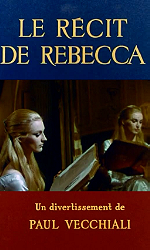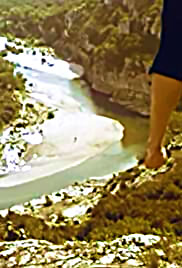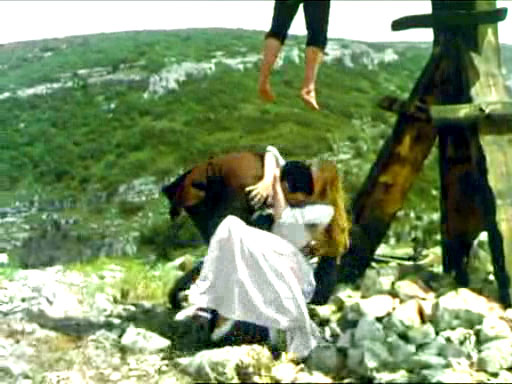 This 33 minute French made featurette from 1964 can lay claim to being the first-ever cinematic transposition of the Polish Jan Potocki’s immortal French language epic THE MANUSCRIPT FOUND IN SARAGOSSA. Written and directed by Paul Vecchiali, it preceded more famous examples like the feature film THE SARAGOSSA MANUSCRIPT (1965) and the miniseries THE DUCHESS OF AVILA (1973), although unlike them THE STORY OF REBECCA (LE RECIT DE REBECCA) only dramatizes a portion of Potocki’s masterpiece: chapter fourteen, to be exact.
This 33 minute French made featurette from 1964 can lay claim to being the first-ever cinematic transposition of the Polish Jan Potocki’s immortal French language epic THE MANUSCRIPT FOUND IN SARAGOSSA. Written and directed by Paul Vecchiali, it preceded more famous examples like the feature film THE SARAGOSSA MANUSCRIPT (1965) and the miniseries THE DUCHESS OF AVILA (1973), although unlike them THE STORY OF REBECCA (LE RECIT DE REBECCA) only dramatizes a portion of Potocki’s masterpiece: chapter fourteen, to be exact.
…the first-ever cinematic transposition of the Polish Jan Potocki’s immortal French language epic THE MANUSCRIPT FOUND IN SARAGOSSA.
As the film begins no less than three narrators are heard, with a never-seen male voice setting the scene, followed by Alphonse Van Worden, the ersatz protagonist, and then Rebecca Mamoun, a beautiful young woman who’s revealed as the film’s true protagonist. It’s she that the Walloon Guard captain Van Worden discovers asleep under a gallows in the Sierra Morena region of Spain (to learn precisely what he’s doing in this place you’ll have to read the book or see the other film adaptations), where two hanged corpses dangle.
 Rebecca’s story, which takes up much of the remainder of the film, is set in and around the La Venta Quemada, an accursed residence where much of THE MANUSCRIPT FOUND IN SARAGOSSA takes place (again, you’ll have to read it to discover precisely what occurs therein). It seems Rebecca has been promised as the future wife of two immortal genii who preside over the Gemini constellation. She tries to evade her fate until her brother Ben, a devoted cabbalist, gives her a book known as Sephiroth, whose cover is made of wood from the Ark of the Covenant and is capable of destroying anyone who gazes upon it.
Rebecca’s story, which takes up much of the remainder of the film, is set in and around the La Venta Quemada, an accursed residence where much of THE MANUSCRIPT FOUND IN SARAGOSSA takes place (again, you’ll have to read it to discover precisely what occurs therein). It seems Rebecca has been promised as the future wife of two immortal genii who preside over the Gemini constellation. She tries to evade her fate until her brother Ben, a devoted cabbalist, gives her a book known as Sephiroth, whose cover is made of wood from the Ark of the Covenant and is capable of destroying anyone who gazes upon it.
One night she spots two winged men—“Divine Twins”—in a mirror. They subsequently appear to her in dreams, where they assume various celestial forms and, inevitably, seduce her–until Rebecca’s mirror shatters. The twins return, though, to perform an unearthly dance for her, and in the process slash up the gown she wears, before reality dissolves and she awakens under the gallows.
 If all this sounds confusing, that’s because it is. A more-than-passing familiarity with THE MANUSCRIPT FOUND IN SARAGOSSA is a requirement, as so much here goes unexplained. The identities of the celestial twins, for instance, are left obscure, even though that’s a rather important part of the story (they are, in fact, manifestations of the two hanged men, who elsewhere in Potocki’s text appear to Alphonse as a pair of seductive women). The fact that so much of the story is related via off-screen narration is another problem, especially since that narration grows insanely complex and labyrinthine.
If all this sounds confusing, that’s because it is. A more-than-passing familiarity with THE MANUSCRIPT FOUND IN SARAGOSSA is a requirement, as so much here goes unexplained. The identities of the celestial twins, for instance, are left obscure, even though that’s a rather important part of the story (they are, in fact, manifestations of the two hanged men, who elsewhere in Potocki’s text appear to Alphonse as a pair of seductive women). The fact that so much of the story is related via off-screen narration is another problem, especially since that narration grows insanely complex and labyrinthine.
If all this sounds confusing, that’s because it is.
Yet from a visual standpoint this film is a near-masterpiece. The locations are extremely well chosen (although they can’t hope to compete with the still-unmatched art direction of Wojciech Has’ take on the material), complimenting an overall atmosphere of magic and enchantment that’s as potent and all-encompassing as those of French-made classics of the form like LA BELLE ET LA BETE and DONKEY SKIN.
…from a visual standpoint this film is a near-masterpiece.
It’s no wonder the film is such a pictorial wonder, as the cinematographer was the great Henri Alekan (1909–2001), whose other credits include the aforementioned LA BELLE ET LA BETE and WINGS OF DESIRE. His facility for the fantastique was unparalleled, as was his expressive use of color; he and Vecchiali work wonders with, for instance, a tiny splash of red amid an otherwise gray outdoor landscape. Credit must also go to the Polish animator Piotr Kamler, who worked on the film as a designer.
Beyond that THE STORY OF REBECCA is marked by psychedelic effects (kaleidoscopic swirls of color, superimpositions, etc.) and dissolve-heavy still photo montages (in scenes that directly anticipate Chris Marker’s photo roman classic LA JETEE). Also featured are some hoary elements, such as the clichéd “fantasy” bell muzak, but this is a definite case of good things far outweighing the bad.
Vital Statistics
THE STORY OF REBECCA (LE RECIT DE REBECCA)
Director: Paul Vecchiali
Screenplay: Paul Vecchiali
(Based on a story by Jan Potocki)
Cinematography: Henri Alekan
Cast: Jean-Pierre Bonnefous, Alain Saury, Jean-Paul Cisife, Marika Green, Youri Rytel
